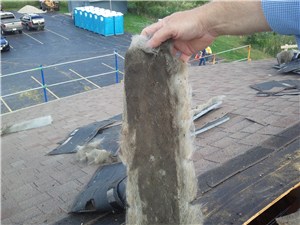Roof Ventilation is a must!
A real issue home owners face is proper roof ventilation. All roofing manufacturers require a roof to be ventilated. There are some exceptions with what are known as 'hot roofs' or insulated panels that comprise the entire roof deck. There is also a move to spray foam the underside of the roof deck to create a 'hot roof' as well - there is still much debate on this though. For our discussion we will focus on a typical vented roof.
The basic concept is that warm air expands and can be displaced by relatively cooler air. Air warmed in an attic space can be moved by passive drafting - the principle that air can be moved out through a higher 'hole' by air being drawn in through a lower 'hole'. This is accomplished by roof vents at the ridge or peak and soffit vents. In principle, this works very well on standard houses. In the summertime, warm air in the attic is expelled through the ridge vent by cooler air being drawn in through the soffit vents. Problems with this formula do occur.
Ridge Vents Can Become Plugged!
Many roofing contractors are surprised when they remove the roof for a reroofing project that the roof ventilation is  totally blocked by wasp nests or dust and mold or mildew. Add to that the intake or soffit vents facing the same problem. The picture to the right shows a ridge ventilation filter entirely blocked off by dust. This means that excessive heat can build up the attic during the summer months leading to premature shingle failure. These filter inserts are used to stop fine snow and insects out of the attic. All filters need to be changed regularly - something that is not easily done on a ridge vent.
totally blocked by wasp nests or dust and mold or mildew. Add to that the intake or soffit vents facing the same problem. The picture to the right shows a ridge ventilation filter entirely blocked off by dust. This means that excessive heat can build up the attic during the summer months leading to premature shingle failure. These filter inserts are used to stop fine snow and insects out of the attic. All filters need to be changed regularly - something that is not easily done on a ridge vent.
What about the winter and ice dams? While the amount of air movement in the winter months is much less, ridge vents can provide some help with ice dams. The concept is that if you keep the attic below freezing, there will be no snow melt from a warm attic. However, there are several problems with that theory:
1) The sun can warm the roof surface leading to snow melt. (This is best seen on a 20 degree sunny day when we see water running down a roof because the roof surface is being warmed by the sun).
2) Ridge or roof vents can be covered by snow and thus do not move any air through them.
3) The air that moves through them melts the snow around it and causes run off that can refreeze at the eaves.
4) The roof ventilation can become clogged and provide little or no ventilation.
5) Complex roof design can lead to areas in the roof where there is little or no air movement.
We are not suggesting that roof venting is not necessary or foolish. It is entirely necessary to keep the attic space cooler in the summer leading to lower cooling costs and longer shingle life. We are suggesting that roof ventilation is not always effective at solving ice dam problems. When that is the case, please do not hesitate to reach out to us to provide you with an effective solutions to your ice dam problems.